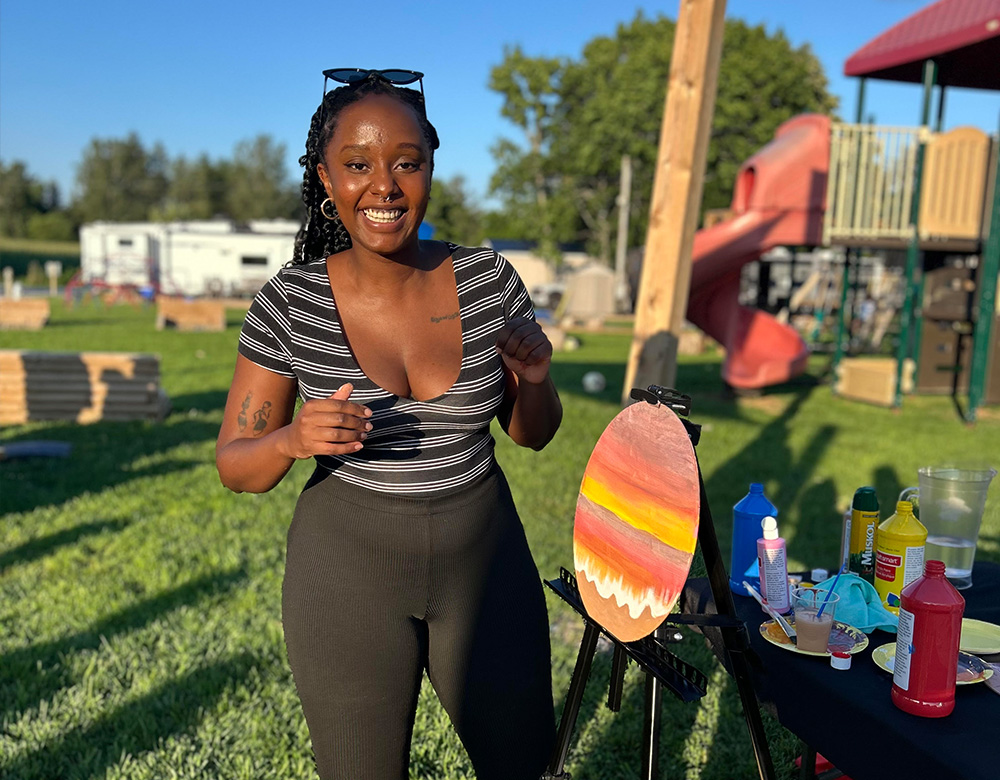Njeri Gitau
Year of birth: 1999
Where do you live: Toronto, Ontario
Your education: Bachelor’s Honours Degree in Psychology (York University)
Describe your art in three words: Colourful, Compositional, Impulsive
Your discipline: Multidisciplinary artist (I use yarn, felt paper, paint, digital art, stickers, resin, markers and colours etc.)
Website | Instagram

You mentioned that your art is deeply inspired by your home country, Kenya. Can you tell us more about how your Kenyan roots influence your artistic expression?
I grew up in Kenya and recently moved to Canada to pursue further education. Everything I learned artistically, I learned back home in Kenya. There, I would observe artists creating colorful pieces of cloth with small decorative animations (commonly known as Kitenge in Kenya) or using fabric as their canvas to depict canyons, wildlife, and tourism.
I also grew up in a very colorful, lively country where people wore their brightest clothes daily, painted their homes in vibrant yellows and oranges instead of the usual white, and where markets overflowed with colorful fruits and vegetables, filling the streets with vibrancy. The Maasai people, with their rich cultural aesthetics, became central to Kenya’s identity. Visitors would recognize Kenya through the culture the Maasai represented—brightly colored clothing, intricately beaded jewelry, and handcrafted sandals.
That is precisely what I want to showcase to the world—art full of color, full of life, and deeply rooted in my Kenyan culture.
Your painting “Africans in The Diaspora” has become a sought-after piece. What was the inspiration behind this painting, and how do you feel about its significance in your journey as an artist?
“Africans in the Diaspora” originally started as a beautiful accident. I was trying out a new technique I had seen on Instagram—placing blobs of paint onto a canvas and then using a squeegee to create an abstract piece. Being the person I am, I assumed it would turn out beautifully on my first try—but that was definitely not the case.
As an emerging artist, I didn’t realize that when colors blend, they often turn into a single brown mass. However, I encouraged myself to let that first layer dry and tackle this abstract expression once again. This time, I placed individual colors around the canvas and let them dry. Once they formed shapes, I envisioned what the piece could become. That’s when I pulled out my acrylic markers and decided to draw the rest of the creation as I saw it in my mind—and that’s how Africans in the Diaspora was born!
The figures in the painting depict the Maasai people, who are traditionally nomadic, constantly wandering in search of a new home and adapting to their environment. I was inspired to portray this because, like them, I left my home a few years ago and had to adapt to the idea of creating a new home in Canada. Essentially, I created this piece to express how I, along with other international Africans, have felt upon arriving in a new country—doing our best to make it a place we love.

You talk about adding “a lot of color” to your work. What role does color play in your art, and how does it contribute to the message you want to communicate?
Colour is honestly everything to me in art! I always thought I needed to become more of a minimalist in life. I tried picking out outfits with the least amount of colour or designing my living space with just one colour pattern so it wouldn’t look too colourful. But the more I tried to change, the more things stayed the same—I learned that colour is my way of showing the world: Hey, this is Njeri Gitau, and she loves colour!
And colour is my expression. I love the way you can use lighter, brighter colours to create depth, or how darker colours can be used to depict shadows and a three-dimensional essence. I love adding colour to mundane objects just to breathe life into them, and experimenting with different combinations to see what works and what doesn’t. For me, it’s the equivalent of taking a child to a candy store!
How does living in Canada impact your art, especially in terms of cultural identity and your connection to your homeland?
I think living in Canada has really helped my art grow and taken it to the next level. In Kenya, I was taught art in a very technical setting in school. My art teacher, God bless her heart, taught me everything she knew and passed down her intricacies to her students in the best way she could.
But in Canada, I learned to fully express each and every one of my ideas and see them through—no matter if they were great ideas or just ones I needed to explore and move on from. I got to experiment with different media, such as felt paper, wool, and resin pouring, which I probably wouldn’t have had the opportunity to explore back in Kenya.
Another interesting thing about living in Canada is that it has actually deepened my connection to my roots in Kenya. Lately, everything I create is tied to what I see back home—whether it’s the hustle culture, a scene I witnessed while visiting, or simply a desire to bring a piece of Kenya to Canada.
I feel like living in Canada has propelled my art forward while also allowing me to stay true to my Kenyan roots!

Can you share more about your creative process? How do you approach a new piece of art, and what steps do you take to bring your ideas to life?
I honestly feel like my creative process changes each and every time, but the general gist is that I start by looking up references or finding a frame of reference for what I truly want to paint and create. This could be a photo I’ve taken—one where I loved the vibrancy—or something I’ve seen while moving around the city that I want to capture in a painting. I then determine where exactly I want to create this, whether on canvas, wooden boards, or digitally.
Once I’ve figured out the medium, I gather my materials and get to work. The great thing about my process is that I create as I go. I don’t have a fixed expectation of when a piece will be finished or what it will look like in the end—I adapt to mistakes and changes in the work as it evolves. This flexibility was a challenge for me back in Kenya, but I’ve given myself the space to explore it more freely here in Canada.
How do you balance your artistic practice with daily life, and what motivates you to keep creating?
Currently, I work as a part-time administrative assistant, and I also run my own art business on Etsy and Instagram. I started my Etsy page, Mikono Moyo, this January—it was something I had been very excited to do for months but hadn’t yet found the courage to start.
Additionally, I am a part-time student currently pursuing my master’s in psychology online, so I’d say there are a lot of different elements of my life running concurrently! Naturally, I would love to give it all up and pursue art full-time because that is where my true passion lies. However, I truly appreciate the fact that I have different aspects of life that don’t revolve around art. I enjoy working and studying in a field that isn’t directly related to art but can still be applied to it.
I usually prioritize my art time after work on most days. At the moment, I find it easier to focus on digital work rather than physically painting, as it allows me to dedicate the time and attention I’d like. For physical paintings, I set aside weekends when I have longer, uninterrupted hours to layer paint, make corrections, and continue creating.
What truly motivates me is knowing what the finished result could be and the excitement of seeing it all come together! I am both my biggest critic and my biggest fan—which, I think, is the curse of being an artist altogether!

You’ve said that art is a reflection of your identity. What do you hope people take away when they experience your art, especially in terms of the cultural stories you tell through your work?
I do understand that while I would absolutely love to capture everyone’s culture in my pieces, I am just one person who can only capture what is essential to me. That is what I hope people take away when they see my art. I hope they realize that Kenya—and, in a broader sense, Africa—is so much more than what is often portrayed in Western media. It is not just poverty-stricken, war-torn, or in constant need. Rather, it is a beautifully rich, diverse, colorful, and vibrant continent that everyone should experience at least once in their lifetime. For me, Kenya especially embodies this cultural richness.
I hope people see the effort and time I put into my work, with each detail created intentionally. I am someone who loves Christ, and one of the gifts Christ offers us as His people is the gift of warmth and love. I want people to feel that warmth and love when they look at my paintings—to know they were created from a place of love and purpose.
But above all, the most important message I want people to take away from my work is the need to pursue life in the direction of their passion. You need to start living with purpose because you were created with purpose. Chase after your passion, embrace your gifts, and run toward the life you were meant to live! I promise—you won’t regret that decision!


Leave a Reply